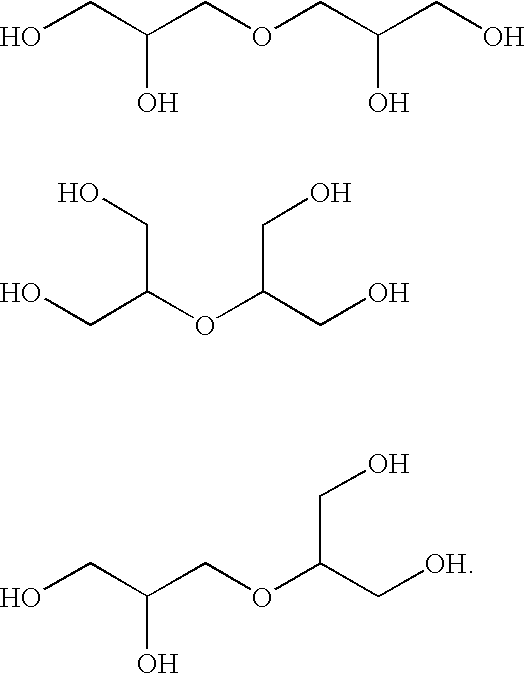Polyol ethers and process for making them
a polyol ether and polyol ether technology, applied in the field of polyol ether making process, can solve the problems of large amount of inorganic salts, difficult stopping reaction, and large molecular weight distribution of products
- Summary
- Abstract
- Description
- Claims
- Application Information
AI Technical Summary
Benefits of technology
Problems solved by technology
Method used
Image
Examples
examples 1-10
n-Butyraldehyde / Ethylene Glycol
[0074]In Examples 1-10, n-butyraldehyde, ethylene glycol, and hydrogen are reacted in the presence of Pd / C at various ratios and / or reaction conditions. The reaction procedure is generally as follows. The n-butyraldehyde, ethylene glycol, and Pd / C are charged to a Parr reactor. The system is purged with nitrogen three times. Then hydrogen is charged, the reactor is heated, and the hydrogen pressure is adjusted as necessary. Following the appropriate reaction time, the product mixture is analyzed by GC. Reaction conditions and GC results are summarized in Table 1.
TABLE 1Conditions and results for 2-butoxyethanol preparationfrom n-butyraldehyde and ethylene glycol.2-n-1,2-PDOEG / BA10% Pd / RxnConv.2-BEBuOHDBEyieldmolarC wt %Temptime,of BA,yield byyield byyield bybyEx.ratioto BA° C.P, psihrsGC %GC, %GC, %GC, %GC, %12051801000210088.77.22.302205180500310085.54.32.51.43202.5180500399.425.81.90.361.041051801000210083.48.34.20.7 5*551801000210079.77.57.70.662052...
example 11
n-Butyraldehyde / Diethylene Glycol
[0077]n-Butyraldehyde (3.6 g, 4.5 ml; 0.05 mol), diethylene glycol (106.1 g, 55.8 ml; 1 mol), and 0.18 g of 10% Pd / C are charged to a 150 ml Parr reactor. The system is purged with nitrogen three times. Then 500 psi of hydrogen is charged, the reactor is heated to 200° C., and set 1000 psi of hydrogen. After 2 hrs at 200° C. and 1000 psi, GC analysis shows complete consumption of n-butyraldehyde and formation of 3,6-dioxa-1-decanol (n-butyl carbitol) (94.5%), n-butanol (3.4%) and 2,2′-dibutoxy ethyl ether (2.1%).
example 12
n-Butyraldehyde / Tetraethylene Glycol
[0078]n-Butyraldehyde (1.8 g, 2.25 ml; 0.025 mol), tetraethylene glycol (97.1 g, 86.3 ml; 0.5 mol), and 0.09 g of 10% Pd / C are charged to a 150 ml Parr reactor. The system is purged with nitrogen three times. Then 500 psi of hydrogen is charged, the reactor is heated to 180° C., and set 1000 psi of hydrogen. After 4 hrs at 180° C. and 1000 psi n-butyraldehyde reacts completely, and GC analysis shows formation of 3,6,9,12-tetraoxahexadecanol (91.2%), n-butanol (4.8%) and 5,8,11,14,17-pentaoxauneicosane (1.1%).
PUM
| Property | Measurement | Unit |
|---|---|---|
| Time | aaaaa | aaaaa |
| Molar ratio | aaaaa | aaaaa |
| Covalent bond | aaaaa | aaaaa |
Abstract
Description
Claims
Application Information
 Login to View More
Login to View More - R&D
- Intellectual Property
- Life Sciences
- Materials
- Tech Scout
- Unparalleled Data Quality
- Higher Quality Content
- 60% Fewer Hallucinations
Browse by: Latest US Patents, China's latest patents, Technical Efficacy Thesaurus, Application Domain, Technology Topic, Popular Technical Reports.
© 2025 PatSnap. All rights reserved.Legal|Privacy policy|Modern Slavery Act Transparency Statement|Sitemap|About US| Contact US: help@patsnap.com



